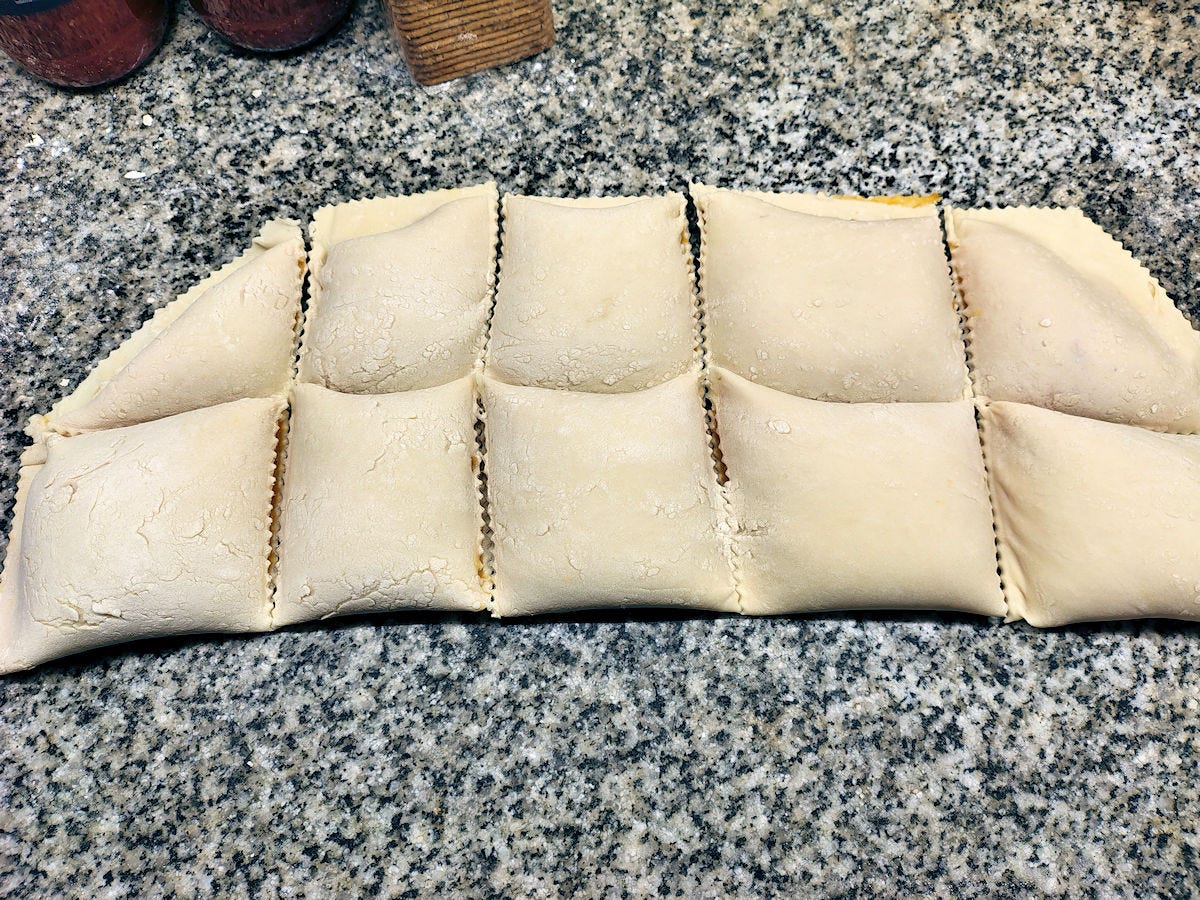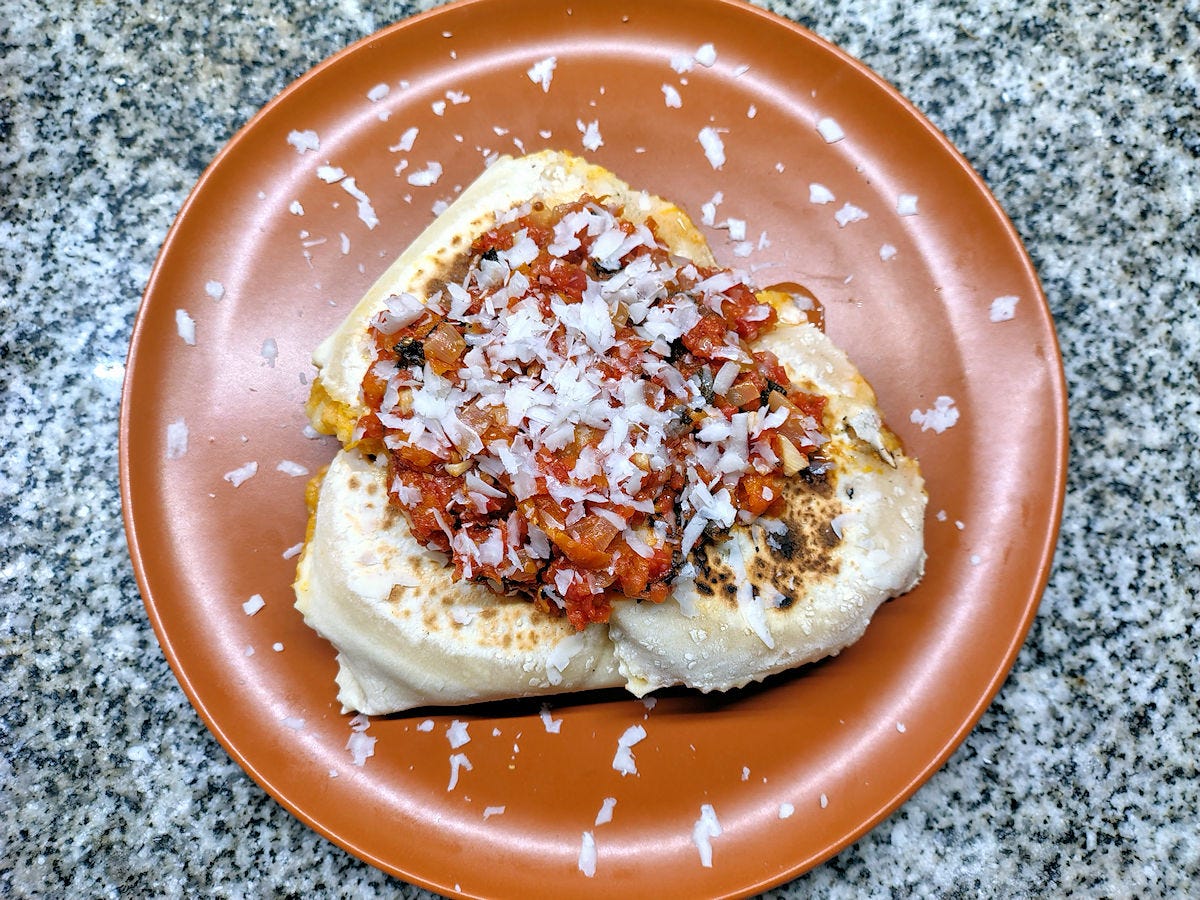The Pop-Tart™ Pasta
We're off to the border of Toscana and Emiglia-Romagna and another notch in our "Peculiar Pastas" belt.
Part of my exploration of pastas has always been to find obscure ones. Often… not, pretty much always… these are pastas I’ve never encountered in the wild, unless you consider the internet and books to be wild. They’re usually pastas that are specific to some small geographic point, and quite often to a particular holiday, and end up being made by three remaining nonnas in town, once a year.
Now, when I think about tortelli or in the singular, tortello, I tend to think of a sort of round, filled pasta shaped sort of like an outie belly button. But further exploration, in some parts of Italy, particularly around the border between Toscana and Emiglia-Romagna, it is a rectangular filled pasta, usually like a giant raviolo. We’re off to another peculiar pasta from the upper Savio valley. The Tortello sulla lastra (literally, “disc on the slab”, and some term it tortello alla lastra, with the same meaning) is, to some food historians, a sort of mini piadina, the soft taco of Emiglia-Romagna proper, made with pasta dough instead of pizza dough. One could certainly draw a line between the two, though there are differences - a piadina isn’t sealed, the size, the fillings - but hey, inspirations come from all sorts of places. I think they look like griddled Pop-Tarts™.
Let’s start with our filling. It’s pretty standardized from all I could find. There are small variations - some folk use just squash and no potato, or vice versa, but most seem to use both. Bacon might be rolled panceta or guanciale, or, in some cases, simply melted lard. Salt, white (or black) pepper, and nutmeg appear to be near universal. Onion or garlic? Rarely - a few recommended putting a garlic clove in the water used to cook the potato or squash but removing it from the final filling - just a hint.
I’m going to assume you can figure out how to boil diced up potatoes and squash. Cooked separately for two reasons. One, they take different times to cook, and two, you want to keep some of the squash cooking water to be used later (or in the potato-only versions, the potato cooking water). Rendering and crisping the bacon, simple - don’t drain off the rendered fat. And, some pecorino cheese comes into play. Some recipes suggested an egg, to help it bind, but most did not.
Mix them all together.
The dough is simple. All purpose flour, a pinch of salt, and the water from cooking the squash. Mixed, kneaded until smooth. Ready.
Let it rest, then roll it out into a big… rectangle, more or less. Interestingly, many of the online demos roll it out into a big round but then end up trimming it down to a rectangle. Just seems a waste of dough to me.
Spread the filling across half the dough, leaving enough room around the edge to seal it. Here’s where I made a mistake - I just simply used up all the filling I had. It’s too much, as you’ll see in a moment. They layer should probably be about half that thickness - like a quarter-inch or half-centimeter - somewhere around there.
Fold the dough over the filling and seal the edge.
The easiest way to do this part is use a thicker plate, and just roll it slowly across the whole tortello to seal individual pockets. You want something thicker so that it creates enough of a seal to cut into individual pieces.
And, cut. Traditionally, a fluted pastry or pasta wheel is used. I could already tell at this point that they were going to burst open. Thank goodness we’re not going to boil these. Did I mention that? Oh yes, I said griddled above.
Tortello sulla lustra is usually served either with a simple sage brown butter, or a sage infused tomato sauce. I went with the latter. Sauté some chopped onion in a little butter or olive oil until soft.
Add some grated carrot and minced garlic and cook for a few more minutes.
Add tomato passata or purée, some sage leaves, salt and pepper, and simmer until thickened.
And, we’re going to cook them on a griddle at low heat. You could obviously do this in a thicker pan as well - cast iron recommended. They’re griddled dry - no oil - basically, we’re toasting them slowly, enough to make sure the pasta dough cooks through.
As predicted, these just burst open. Had there been less filling, and maybe a slightly wider seal between each piece, that wouldn’t have happened. I don’t plan to make these again, it was more curiosity than anything, so if you want prettier versions, you can find pictures on the ‘net.
Still, they at least held together, even if the edges burst.
And, served with the reduced tomato sauce and a good grating of some more pecorino.
They’re good, but I can’t say we were overly enthused. A trio of us ate them all, but none of us would have wanted more. I actually think they might have been better with the brown butter and sage sauce - I though the tomato sauce clashed a bit with the filling. And the filling needs to be amped up a bit - I can see why some folk add a little garlic or onion to it. Maybe a bit more salt and pepper too. Even, though not remotely traditional, a touch of chili flakes. Or, hey, just make up a different filling. There are versions out there that people have made with completely different ones, even if not traditional. In the end, they’re just kind of big, griddled ravioli.
I’d rather just make a piadina. Faster, easier, and more versatile.


















